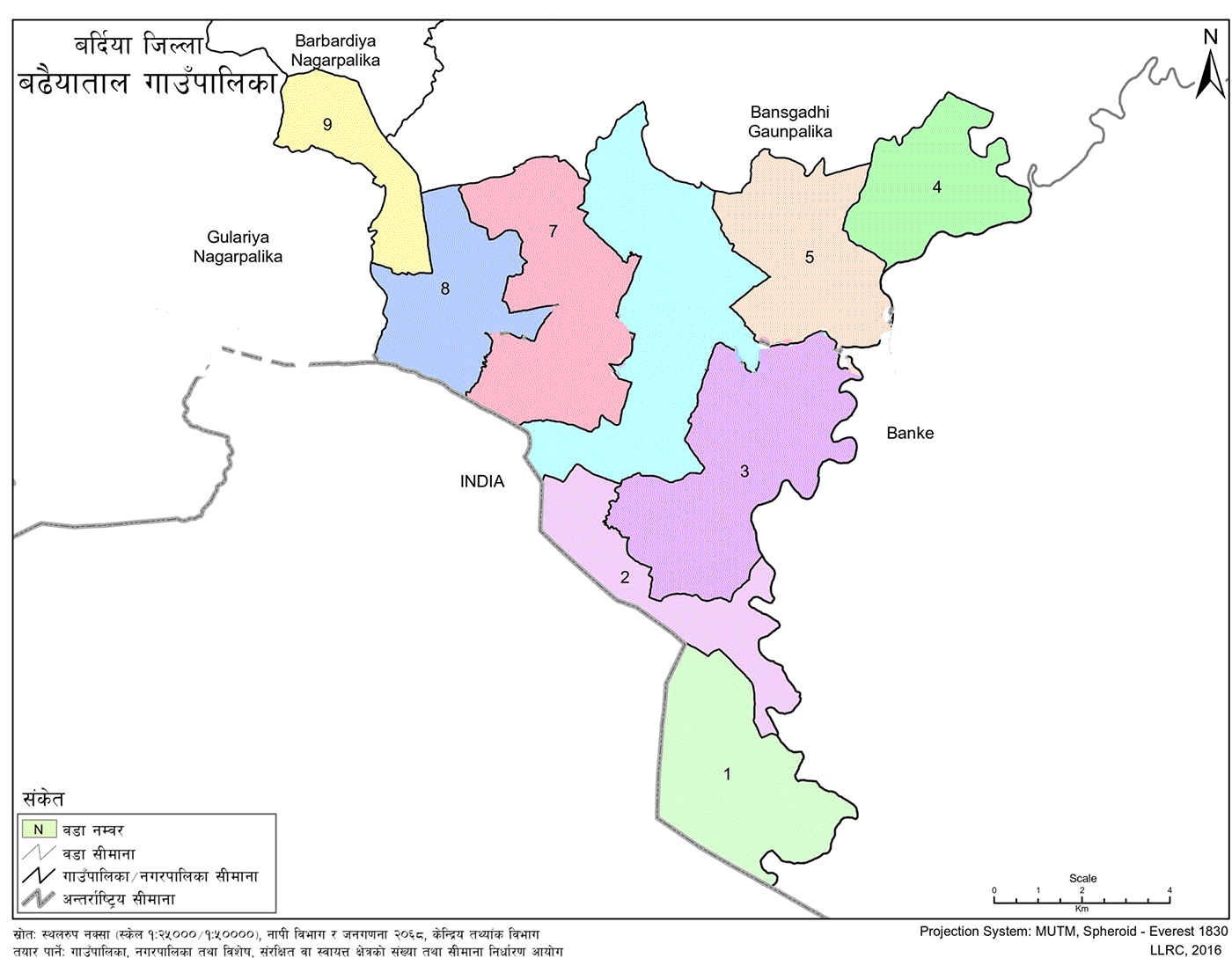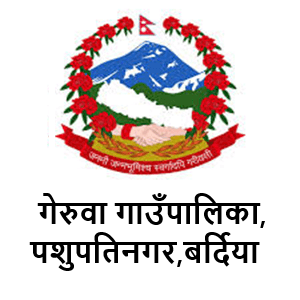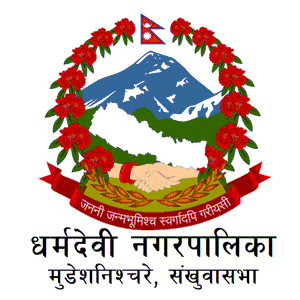Overview
Badhaiyatal Rural Municipality (Gaunpalika - बढैयाताल गाउँपालिका, बर्दिया) is a culturally rich and geographically significant local government unit in Bardiya District, Lumbini Province, Nepal. Known for its iconic Badhaiya Lake, historic Kalika Temple, scenic Duimohana, and the revered Nagmani Nath shrine, it attracts both internal and external visitors throughout the year. These features give Badhaiyatal a unique identity rooted in natural beauty and cultural heritage.
The municipality lies between 81°23′17" to 81°33′49" east longitude and 28°04′11" to 28°13′58" north latitude. It spans a total area of 115.19 square kilometers and sits at an elevation between 143 and 157 meters above sea level. Geographically, it is surrounded by Basgadhi Municipality in the north, Gulariya Municipality in the west, the international border with India in the south, and Banke District in the east. Badhaiyatal was officially declared a rural municipality on Falgun 27, 2073 BS (2017 AD).
Highlights of Badhaiyatal Rural Municipality
| Key Features | Details |
|---|---|
| Province | Lumbini Province |
| District | Bardiya District |
| Total Area | 115.19 sq. km |
| Elevation | 143 m to 157 m above sea level |
| Latitude/Longitude | 28°04′11″ – 28°13′58″ N / 81°23′17″ – 81°33′49″ E |
| Established | 2073/11/27 BS |
| Neighboring Units | North: Basgadhi Municipality South: India East: Banke West: Gulariya Municipality |
| Total Wards | 9 |
| Population Composition | 39.2% Madhesi Indigenous, 26.9% Brahmin-Chhetri, others: Dalit, Janajati |
| Schools | 53 public and private schools |
| Main Occupation | Agriculture, Trade, Livestock, Foreign Employment |
| Major Rivers and Streams | Man Khola, Daduwa, Chapala Nala, Gyang River |
| Natural Attractions | Badhaiya Lake, Duimohana, Kalika Temple, Nagmani Dham |
| Cultural Events & Fairs | Teej, Maghi Mahotsav, Krishna Janmashtami, Karbala Festival, Chhath |
| Economic Potential | Modern agriculture, Herbal industries, Fish farming, Tourism |
| Environmental Zones | Wetlands, Community Forests, Agricultural plains |
| Challenges Identified | Road infrastructure, Health services, Youth unemployment, Water and sanitation |
| Development Focus Areas | Education, Vocational Training, Renewable Energy, Market Access |
Geographic and Climatic Conditions
Badhaiyatal falls in the Terai region of Nepal, which is known for its flat and fertile plains. The land here is highly suitable for agriculture. However, in recent years, the expansion of settlements and population growth have led to the fragmentation of agricultural land.
The municipality experiences a tropical to subtropical climate. The weather pattern varies significantly throughout the year. Summer, which begins in Chaitra and lasts till early Ashwin, is hot and humid. The monsoon brings abundant rainfall from late Jestha through Ashwin, driven by the southern winds. Winter, especially in Mangsir, Poush, and Magh, can be significantly cooler.
In 2074 BS, the recorded temperatures ranged from a chilly 7.7°C in the winter to a scorching 42.2°C in the peak summer months. These temperature extremes affect both agriculture and daily life, making seasonal planning essential for farming and infrastructure development.
Demographic Composition
Badhaiyatal is a vibrant mix of ethnicities, castes, and religions. According to the household survey conducted in 2074 BS:
-
39.2% (19,571 individuals) belong to the Madhesi indigenous community
-
26.9% (13,452 individuals) are from the Brahmin-Chhetri groups
-
Other groups include Hill Dalits, various Janajati communities, and other Terai-based ethnicities.
This diversity adds cultural richness and is reflected in the various festivals, traditions, and daily interactions across the community.
Education and Learning Environment
The municipality is home to 53 public and private schools, ranging from early childhood education to higher secondary level. These institutions serve not only local students but also those from neighboring municipalities and districts who come seeking better educational opportunities.
While a significant number of households are connected to electricity, some marginalized communities still lack access to basic utilities. This affects their ability to benefit fully from modern amenities, including access to digital learning resources.
Economic Activities and Livelihood
Agriculture is the backbone of the local economy. Families typically engage in farming as their primary occupation. Major crops include grains, vegetables, and cash crops like ginger. Livestock farming and poultry also contribute to household income. Many families are also involved in small-scale businesses and seasonal trade.
Remittances from foreign employment and urban jobs provide additional income sources. With many young residents migrating abroad for work or study, there is a growing interest in alternative livelihoods such as commercial farming and entrepreneurship.
Despite having fertile land, agricultural productivity remains limited due to a lack of irrigation, modern tools, and access to quality seeds and fertilizers. However, the potential for growth remains high.
Administrative and Political Structure
Badhaiyatal Rural Municipality was formed by merging several former Village Development Committees (VDCs), namely Jamuni, Sorhawa, Kalika, and Mainapokhar. It is now structured into 9 wards.
Ward Division Details
-
Jamuni VDC: Wards 6 to 9
-
Jamuni VDC: Wards 1 to 5
-
Sorhawa VDC: Wards 6 to 9
-
Sorhawa VDC: Wards 3 to 5
-
Sorhawa VDC: Wards 1 and 2
-
Mainapokhar VDC: Ward 3
-
Mainapokhar VDC: Wards 1, 2, 4, 6, 8, 9
-
Mainapokhar VDC: Wards 5 and 7
-
Kalika VDC: Wards 1 to 9
Natural Resources and Environmental Outlook
Badhaiyatal is blessed with natural resources, including rivers, lakes, forests, and fertile plains. Major rivers and water bodies, such as the Man Khola, Daduwa River, Chapala Nala, and Gyang River, provide water for irrigation and household use. These areas also support fish farming and are home to rare bird and reptile species.
Community forests are home to medicinal herbs and non-timber forest products that have both economic and ecological value. Sustainable management of these resources can help improve livelihoods and ensure environmental conservation.
Climate and Rainfall Trends
The municipality receives significant rainfall during the monsoon months, mainly from late Jestha to Ashwin. This seasonal rain is essential for farming, but can also lead to flooding and erosion if not correctly managed. Average temperatures can reach up to 41°C in summer and drop to as low as 7°C in winter. These shifts impact agriculture, health, and infrastructure.
Cultural and Religious Festivals
Badhaiyatal celebrates a variety of festivals that reflect its multicultural identity:
-
Dashain
-
Tihar
-
Maghi
-
Holi
-
Maha Shivaratri
-
Krishna Janmashtami
-
Chhath
-
Eid (Bakr Eid and Ramzan)
-
Christmas
These festivals are observed with deep community participation and often include fairs, rituals, and social gatherings. They foster a sense of belonging and provide opportunities for cultural expression.
Popular Local Fairs and Events
-
Teej Fair – Sitla Bazar (Bhadra)
-
Gaijatra – Munal Basti
-
Teej Mahotsav – Ward 7, Pachasa
-
Maghi Mahotsav – Pokatiya
-
Maitadevi Mela – Magh 1
-
Badhaiya Tal Mela – Celebrated during Holi, Dashain, and Tihar
-
Krishna Janmashtami and Tajia – Ward 5
-
Maghi Mela – Duimohana, Ward 4
-
Karbala Mahotsav – Ward 4
-
Christmas and Bakr Eid – Bholaraudhi area
These events draw people from all walks of life and serve as significant cultural touchpoints for the community.
Key Challenges
-
Limited employment opportunities within the municipality
-
Unpaved and underdeveloped roads
-
Inadequate sanitation and drinking water systems
-
Teacher shortages in schools
-
Insufficient staff and resources in health facilities
-
Agricultural land fragmentation and limited irrigation infrastructure
-
Increasing youth migration due to a lack of job opportunities
-
Environmental degradation and unmanaged urbanization
Solutions and Development Priorities
-
Recruit more qualified teachers and renovate the school infrastructure
-
Promote literacy through adult education and child learning programs
-
Expand health services and run awareness programs in all wards
-
Upgrade roads, electricity lines, and irrigation systems
-
Encourage scientific and organic farming methods
-
Support biogas and renewable energy use in households
-
Set up vocational training centers for youth
-
Develop infrastructure for tourism and local industries
Regional Relations and Cooperation
Badhaiyatal maintains strong ties with neighboring municipalities and the District Coordination Committee. Shared roads, markets, schools, and employment opportunities link residents with other local governments. Seasonal migration from hilly regions to the Terai and cross-border movement further strengthen these relationships.
Wetlands and Conservation
Wetlands in the area, including ponds and lowland marshes, are vital for biodiversity. They support rare species of birds, amphibians, and aquatic life. These ecosystems also serve practical needs, such as irrigation and providing drinking water for livestock.
Reviving traditional ponds and developing fish farming in these areas can generate local employment while promoting ecological sustainability.
Tourist and Religious Attractions
Badhaiya Lake stands as a central attraction, both spiritually and environmentally. Other important sites include:
-
Duimohana – a scenic confluence of rivers
-
Nagmani Dham – a pilgrimage center
-
Mainadevi Temple – a historic shrine visited during Maghi
These places have the potential to be developed further as ecotourism and cultural heritage destinations.
Rest Stops and Community Landmarks
Traditional community resting areas, such as pati, pauwa, and chautara, are still found in Badhaiyatal. In earlier times, these served travelers and farmers as shelters. Today, they are used for informal gatherings and community discussions. Preserving these public spaces is part of protecting the social fabric of the community.
Parks and Recreational Areas
There are nine identified picnic spots and natural parks across the municipality. With proper investment, these spaces can offer mental refreshment and serve as venues for outdoor education, family events, and eco-tourism.
Looking Ahead
Badhaiyatal Rural Municipality is a growing community with vast potential in agriculture, tourism, small industries, and environmental sustainability. By addressing current challenges with smart planning and community involvement, it can build a stronger, more inclusive future for its residents.
Investing in education, health, infrastructure, and local entrepreneurship will be key. At the same time, protecting natural resources and celebrating cultural diversity will ensure that development is meaningful and sustainable for generations to come.






